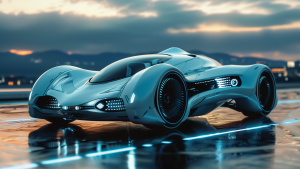The intersection of technology and automotive engineering is reshaping how we design, build, and drive cars. From autonomous systems to electrification, this article delves into the breakthroughs transforming transportation. Discover how AI, connectivity, and sustainability are creating smarter, safer, and cleaner vehicles—and what this means for the future of mobility.
Autonomous Vehicles and AI Navigation

The race toward fully autonomous vehicles has shifted from science fiction to a sensor-driven engineering challenge, powered by breakthroughs in LiDAR, radar, and machine learning. While early systems relied on basic cameras and ultrasonic sensors, modern self-driving platforms fuse 360-degree LiDAR point clouds, millimeter-wave radar for all-weather detection, and neural networks trained on petabytes of driving data. Companies like Waymo and Tesla represent diverging philosophies: Waymo’s LiDAR-centric approach offers precise 3D mapping, while Tesla bets on vision-only Autopilot, leveraging 8 cameras and AI to interpret environments like a human driver—albeit with ongoing debates about reliability.
The SAE autonomy levels (0-5) frame progress:
– Level 2 systems (e.g., Tesla’s FSD) handle steering and acceleration but require driver oversight.
– Level 4 vehicles, like Waymo’s robotaxis in Phoenix, operate geofenced with no human intervention.
Machine learning algorithms now tackle “edge cases”—rare scenarios like erratic pedestrians—through simulation and real-world testing. Yet ethical dilemmas persist: How should AI prioritize safety during unavoidable accidents? Regulatory fragmentation complicates deployment, with the EU mandating stricter data privacy than the U.S., while countries like Japan test autonomous buses in rural areas.
Beyond passenger cars, autonomy is reshaping logistics. Startups like TuSimple deploy self-driving trucks for freight, while Nuro’s delivery pods navigate suburban streets. However, public skepticism remains a barrier. A 2023 AAA survey revealed 68% of drivers fear fully autonomous systems, underscoring the need for transparent safety validation. As AI navigation evolves, interoperability with smart city infrastructure—like traffic lights communicating directly with vehicles—could unlock smoother transitions to higher autonomy levels, bridging today’s incremental advances with tomorrow’s driverless reality.
Electric Vehicles and Battery Innovations
The shift toward electric vehicles (EVs) is accelerating faster than predicted, driven by breakthroughs in battery technology and a global push for decarbonization. While autonomous systems redefine how we drive, EVs are transforming what we drive. Central to this revolution are advancements in lithium-ion batteries, which have seen energy density improvements of over 300% since 2010, enabling ranges exceeding 400 miles. Tesla’s 4680 cell design—featuring a tabless architecture—reduces costs and charging times, while legacy automakers like GM and Ford leverage partnerships with firms like LG Chem and SK Innovation to scale production of modular platforms such as Ultium.
The next frontier is solid-state batteries, which replace liquid electrolytes with solid materials, offering higher energy density, faster charging, and reduced fire risks. Toyota plans to debut solid-state tech by 2027, while startups like QuantumScape aim to commercialize it for mass-market EVs. However, manufacturing scalability remains a hurdle.
Charging infrastructure is catching up, with Tesla’s Supercharger network setting a benchmark for reliability and speed. Rivian’s Adventure Network targets off-road enthusiasts with high-power chargers in remote areas, while governments invest in projects like the U.S. National Electric Vehicle Infrastructure (NEVI) program. Bidirectional charging—enabling cars to power homes or grids—is gaining traction, bridging EV tech with the emerging vehicle-to-everything (V2X) ecosystems discussed later.
Sustainability concerns linger. Mining rare-earth minerals like cobalt and lithium raises ethical and environmental issues, pushing brands to adopt recycled materials and alternative chemistries. Tesla’s Nevada Gigafactory now recycles battery scrap onsite, and startups like Redwood Materials aim to create closed-loop supply chains.
As legacy automakers phase out combustion engines by 2035, the EV landscape is becoming a battleground for innovation—one where energy storage and ethical sourcing are as critical as horsepower. This evolution sets the stage for deeper integration of connectivity and IoT, where EVs will act not just as transport, but as smart nodes in a networked world.
Connected Cars and IoT Integration
As the automotive industry shifts from fossil fuels to electric powertrains, cars are becoming more than just energy-efficient—they’re evolving into intelligent nodes within a vast interconnected ecosystem. Vehicle-to-everything (V2X) communication is enabling cars to “talk” to traffic lights, pedestrian devices, other vehicles, and cloud systems, creating a synchronized network that enhances safety and efficiency. For instance, a connected electric vehicle (EV) can receive real-time data from nearby charging stations to optimize route planning, supplementing the battery advancements discussed earlier.
The rollout of 5G networks has accelerated this transformation, offering ultra-low latency and high bandwidth for features like immersive augmented reality dashboards and remote diagnostics. Automakers like General Motors and Tesla now deploy over-the-air (OTA) updates to refine battery management algorithms, add autonomous driving capabilities, or even upgrade suspension firmware—all without a dealership visit.
IoT integration is reshaping user experiences:
– Infotainment systems now personalize cabin environments using biometric sensors and cloud-based profiles.
– Predictive maintenance leverages onboard sensors and AI to detect component wear before failures occur, reducing downtime.
– Dynamic traffic optimization uses crowd-sourced data to reroute fleets in real time, cutting emissions by minimizing idling—a critical bridge to the sustainability themes in upcoming chapters.
However, hyper-connectivity introduces significant cybersecurity risks. Hackers could exploit OTA update vulnerabilities or manipulate sensor data to disrupt autonomous systems. Standardization initiatives like ISO/SAE 21434 aim to establish unified cybersecurity protocols, while consortiums like the 5G Automotive Association work to harmonize V2X communication frameworks globally.
Legacy automakers and startups alike face a dual challenge: integrating these technologies seamlessly while ensuring interoperability across regions. As cars morph into software-driven platforms, the industry’s success hinges on balancing innovation with robust safeguards—a foundation for the eco-friendly manufacturing advancements explored next.
Sustainable Manufacturing and Materials
As connectivity reshapes how cars interact with the world, the automotive industry is equally focused on redefining how vehicles are built. Sustainable manufacturing is no longer an afterthought but a core pillar of automotive innovation, driven by technologies that minimize environmental impact without compromising performance.
Central to this shift is 3D-printing, which enables precise, waste-free production of lightweight components. Companies like Local Motors and Divergent 3D are pioneering additive manufacturing for chassis parts and structural elements, reducing material use by up to 70% compared to traditional methods. These components not only lower energy consumption during production but also enhance vehicle efficiency by cutting weight. Complementing this, automakers are integrating recycled plastics into interiors and body panels—Ford’s use of ocean-harvested plastics in wiring harnesses and BMW’s recycled nylon seats exemplify this trend.
Beyond materials, hydrogen fuel cells are emerging as a viable alternative to lithium-ion batteries, particularly for heavy-duty vehicles. Toyota’s Mirai and Hyundai’s XCIENT fuel cell truck highlight advancements in hydrogen storage and efficiency, offering longer ranges and faster refueling than EVs, albeit with infrastructure challenges. Meanwhile, bio-based materials—such as flax fibers in Polestar’s panels or mushroom-based leather alternatives—are reducing reliance on petroleum-derived textiles.
BMW’s i Vision Circular concept encapsulates this philosophy, featuring a 100% recyclable design with modular components that can be disassembled and repurposed. The automaker’s pledge to achieve carbon-neutral factories by 2030, using renewable energy and closed-loop water systems, underscores the industry’s systemic changes. Similarly, Volvo’s Chengdu plant operates entirely on green electricity, proving scalability.
These innovations reflect a broader alignment between technological progress and ecological responsibility, setting the stage for safer, cleaner mobility solutions. As manufacturing evolves, so too does the foundation for next-generation vehicle systems—paving the way for smarter, more responsive driving technologies.
Advanced Driver-Assistance Systems (ADAS)
Advanced driver-assistance systems (ADAS) mark a critical shift toward safer, more intelligent vehicles, building on innovations in sustainable manufacturing while paving the way for shared mobility ecosystems. Technologies like adaptive cruise control, which adjusts speed based on traffic flow, and lane-keeping assist, which gently steers drifting vehicles back into alignment, rely on a fusion of cameras, radar, and LiDAR. These systems are augmented by automatic emergency braking (AEB), which uses real-time data to prevent collisions—reducing rear-end crashes by up to 50%, according to the Insurance Institute for Highway Safety.
Central to ADAS evolution are neural networks, which process sensor data to identify pedestrians, cyclists, and vehicles with unprecedented accuracy. By training on millions of diverse driving scenarios, these machine learning models minimize false positives—such as mistaking shadows for obstacles—and adapt to edge cases like erratic weather. Tesla’s Autopilot and Mobileye’s EyeQ chips exemplify how iterative learning improves object detection, reducing accident risks by up to 38% in vehicles equipped with combined ADAS features.
The safety benefits have tangible insurance implications. Insurers like Progressive and Allstate now offer usage-based policies, discounting premiums for drivers using ADAS-equipped cars. A 2023 study by the Highway Loss Data Institute found that vehicles with AEB and lane-keeping assist saw insurance claim frequencies drop by 27%. However, repair costs for damaged sensors and calibration complexities pose new challenges, complicating claims processes.
As ADAS matures, its role in shared mobility becomes clearer. These systems lay the groundwork for fully autonomous ride-hailing fleets, aligning with Mobility-as-a-Service (MaaS) models that prioritize safety and efficiency. Coupled with sustainable manufacturing practices, ADAS ensures that next-gen vehicles are not only eco-friendly but also intelligent enough to navigate increasingly dynamic urban landscapes—a prerequisite for redefining transportation in the decades ahead.
Shared Mobility and Ride-Hailing Platforms
The rise of shared mobility platforms has fundamentally altered the relationship between consumers and car ownership. Apps like Uber and Lyft have normalized access-over-ownership models, particularly in urban areas, where studies suggest a single ride-hailing vehicle can replace up to 15 privately owned cars. A 2023 UC Davis report found that 25% of millennials in major cities have delayed or avoided purchasing a vehicle due to these services. This shift is amplified by electric scooter networks and bike-sharing systems, which address the “last mile” problem, seamlessly connecting users to public transit hubs.
Car-sharing models like Zipcar and Turo further decouple transportation from ownership, while Mobility-as-a-Service (MaaS) platforms integrate these options into unified apps. Helsinki’s Whim, for example, combines trains, buses, taxis, and rentals under one subscription, reducing reliance on personal vehicles. However, urban planners face challenges: ride-hailing contributes to congestion in dense areas, and cities must redesign infrastructure to prioritize micro-mobility lanes and dedicated pickup zones.
- Emission reductions hinge on electrification. Uber aims for 100% zero-emission rides in Europe by 2030, but current data shows ride-hailing trips generate 69% more emissions than the journeys they replace due to “deadheading”—vehicles driving empty between fares.
- Autonomous driving tech, building on ADAS advancements, could optimize shared fleets by minimizing deadheading and enabling 24/7 utilization, though this relies on unresolved regulatory frameworks.
The true potential of MaaS lies in data-driven urban ecosystems. Real-time analytics could balance demand across modes, while AI—previously discussed in ADAS contexts—might predict traffic flows. Future integration with quantum computing (explored next) could unlock hyper-efficient routing models, accelerating the transition from car-centric cities to multimodal, low-emission networks.
Quantum Computing and Future R&D
As shared mobility services reshape transportation’s social fabric, quantum computing emerges as a silent disruptor in the labs where tomorrow’s vehicles are conceived. Unlike classical computers, which struggle with molecular-level simulations, quantum systems model atomic interactions with unparalleled precision. This capability is turbocharging materials science—particularly in developing next-gen batteries. Researchers are leveraging quantum algorithms to uncover electrolyte compositions and cathode materials that could enable solid-state batteries with twice the energy density of today’s lithium-ion cells. Partnerships like IBM-Daimler, which focuses on quantum-driven chemistry simulations for EV battery efficiency, hint at breakthroughs that might shrink charging times to minutes while extending ranges beyond 1,000 kilometers.
Aerodynamics, another critical frontier, is also being rewired. Quantum simulations analyze turbulent airflow patterns in hours instead of weeks, enabling designs that minimize drag with fractal-like surface textures or adaptive body shapes. BMW and Airbus have already demonstrated early applications, optimizing components for reduced energy consumption—a silent nod to the emission-reduction goals highlighted in urban mobility strategies.
Meanwhile, AI-driven prototyping is compressing R&D timelines. Neural networks trained on quantum-generated data can predict material behaviors under extreme conditions, allowing engineers to virtually test thousands of alloy variants for lightweight chassis or hypersonic vehicle skins. Startups like Zoilo are experimenting with AI-quantum hybrids to design hydrogen storage systems, while NASA explores metamaterials for thermal shielding in hypersonic travel.
These innovations feed into a long-term vision where vehicles transcend current limits—think electric planes or vacuum-tube transports. Crucially, quantum advancements align with automotive sustainability targets: better batteries enable smaller carbon footprints, while aerodynamic gains reduce energy waste. Yet, this revolution remains collaborative. Auto giants, tech firms, and startups increasingly share quantum R&D risks, recognizing that the road to transformative mobility runs through subatomic landscapes.
Conclusions
The fusion of tech and automotive innovation is accelerating at unprecedented speeds. From AI-powered autonomy to green manufacturing, these advancements promise safer roads, cleaner energy, and reimagined mobility ecosystems. As industries converge, consumers and businesses must adapt—ushering in an era where cars aren’t just vehicles, but intelligent platforms shaping our daily lives.
















